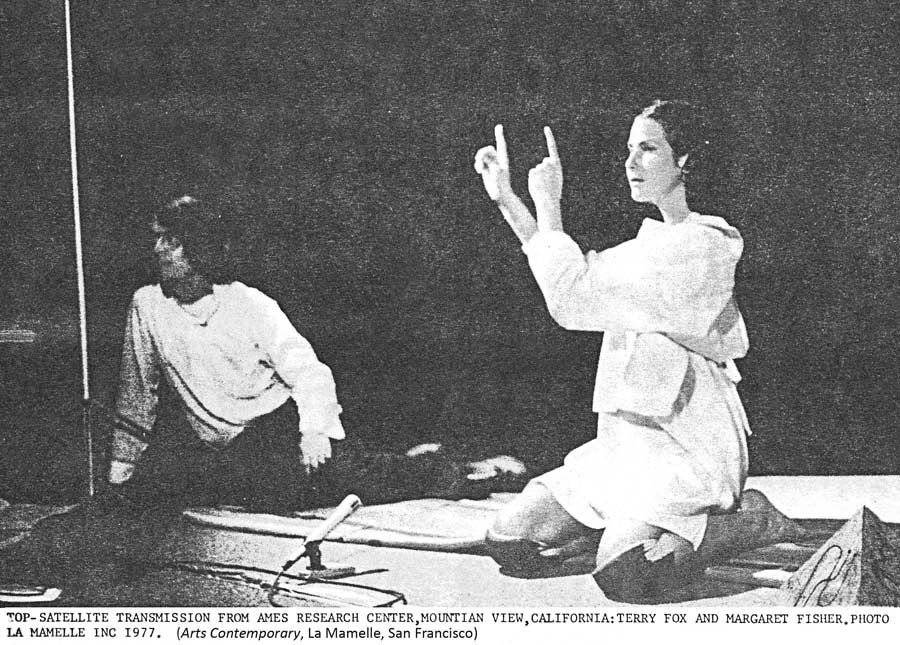Send / Receive Satellite Network

Photo © Richard Lowenberg Video below. More information...
About the work
from the choreographer: “I first remember sensing a rising tide of horror at the prospect of seeing a face from New York appear on the right hand monitor and call us out name by name: Terry Fox, Sharon Grace, Carl Loeffler, alan Scarritt, Richard Lowenberg, Margaret fisher. The power held by the monitor was immense. A few days before, Brad Gibbs, head of communications at Ames Research Center of NASA at Moffett Field in Mountain View CA, had confided his own fears of satellite communication to us. He felt this was an instrument as yet unchecked for the terrific ramifications it could hold and the political and psychological impact of which it was capable. The potential of satellite communication systems in the hands of the public scared him.”Download Fisher's 6-page account.
from the Video Data Bank: “A primer in satellite system operation, Send/Receive extends the critique of media as commodity by asking questions concerning the people's right to access satellites. The objective of Send/Receive was specifically to connect groups of artists on the East and West Coasts via public satellite, and it was the first artist-initiated project to do so. Part I presents an in-depth study of the politics and possibilities of using satellite networks to establish a two-way communication system for public use, as opposed to the industry-driven, militaristic and mass media uses to which satellites are currently restricted. Part 2 excerpts a live satellite feed between New York City and San Francisco.”
sendreceivesatellitenetwork.blogspot.com: “The demonstration was entirely co-ordinated by artists with the support of PISA (Public Interest Satellite Association) and NASA. The now defunct CTS satellite, an experimental satellite jointly owned by NASA and the Government of Canada, was used for the demonstration. The participants were visual artists, video/filmmakers, dancers and musicians, and the demonstration consisted of both verbal interactions and non-verbal performances. Dancers Nancy Lewis (NY) and Margaret Fisher (San Francisco) responded to each other's movements; sculptor Alan Scarritt did a feedback loop which later formed the basis for an installation at the Museum of Modern Art. The Franklin Street group demonstrated the infrared laser link they had set up to get the signal from the Battery City Park landfill, where the New York participants were located, to Manhattan Cable's upstream trunk line so that it could go out to cable viewers...Because of the pioneering nature of this demonstration, there were a number of technical problems which resulted in our transmission time being cut in half.”
from Rachel Wetzler, rhizome magazine “Send/Receive was a two-day project for which the artists set up a two-way satellite link between New York and San Francisco. Using a CTS satellite co-owned by NASA and the Canadian government, artists on either side of the country were able to collaborate in real time, with the resulting program broadcast to viewers on Manhattan Cable's public access channel. The project unfolded in two phases, with the first considering the implications of satellite technology and the second a demonstration of its collaborative and artistic possibilities.”
“[Artist Alan Scaritt] created a feedback loop by pointing a video camera at the television set at the ground station in San Francisco and transmitted the video via the satellite to New York, while dancers Lewis and Fisher responded to each other’s movements from opposite sides of the country. Describing the questions informing Send/Receive, Sonnier and Bear wrote, ‘What are the implications of simultaneity? Of instant exposure and instant response?’”
“As [Keith] Sonnier noted in an interview..., one of the most significant aspects of Send/Receive was that it had happened at all: ‘The media is so completely politically controlled [that] the focus became less and less about making work as illustrating this huge propaganda tool. Acquiring that tool was the political thrust—making that tool culturally possible….Send/Receive was the culmination of a learning experience.’ With Send/Receive, the artists not only explored the artistic uses of satellite technologies and the nature of telecommunications as a medium, but also began to articulate the political potential of artists’ use of them.” Read the entire article
from Willoughby Sharp for orbit news “On September 10 and 11, 1977, the first two-way live broadcast between New York and San Francisco took place. Put into position in 1976, the NASA Satellite CTS was used for the occasion. The New York-based TV station, MCTV, received a cable signal by satellite. Throughout the two-and-a-half hour-long broadcast, the two-way telecommunication was the central theme, texts are read, video material recorded and discussed. The broadcast reached almost 25,000 spectators.”
Credits
- Produced by: Liza Bear, Keith Sonnier, and Sharon Grace, with La Mamelle/Artists Television Access
- Participating artists, NASA/Ames Research Center, Mountain View: Margaret Fisher, Terry Fox, Sharon Grace, Carl Loeffler, Richard Lowenberg, and Alan Scarritt
- Participating artists, lower Manhattan: Liza Bear, Willoughby Sharp, Keith Sonnier, Richard Landry, Nancy Lewis, Richard Peck, Betty Sussler, Paul Shavelson, and Duff Schweninger
- NASA/Ames public relations sponsor: Brad Gibbs
- Experiments with satellite communications: NY Museum of Modern Art / download pdf
Video
Send/Receive September 11, 1977, from MAFISHCO archive.